Individual L&D Plan for Professional Development at CSC
VerifiedAdded on 2020/02/24
|21
|5297
|25
Report
AI Summary
This report details the preparation of an individual Learning and Development (L&D) plan, focusing on the Civil Service Commission (CSC). The student, a senior graduate, outlines the importance of L&D for enhancing professional competencies and aligning with CSC's strategic goals. The report includes an executive summary, table of contents, and self-introduction. It explores the 'Big Picture,' industry-specific megatrends and challenges, CSC's goals, professional values, ethics, and social responsibility. Key components include competency assessments (socio-cultural, personal, managerial, and technical), identification of required competencies, and a proposed professional development program. The document emphasizes the CSC L&D Philosophy and Curriculum Framework, aiming to attract and retain talent, improve performance, and address competency gaps within the organization. The report covers topics such as the scope and responsibility for learning, planning and development, and evaluating the impact of training programs. Challenges like dealing with change, developing leaders, engaging learners, and quantifying training effectiveness are also discussed, providing a comprehensive overview of L&D strategies within the CSC.
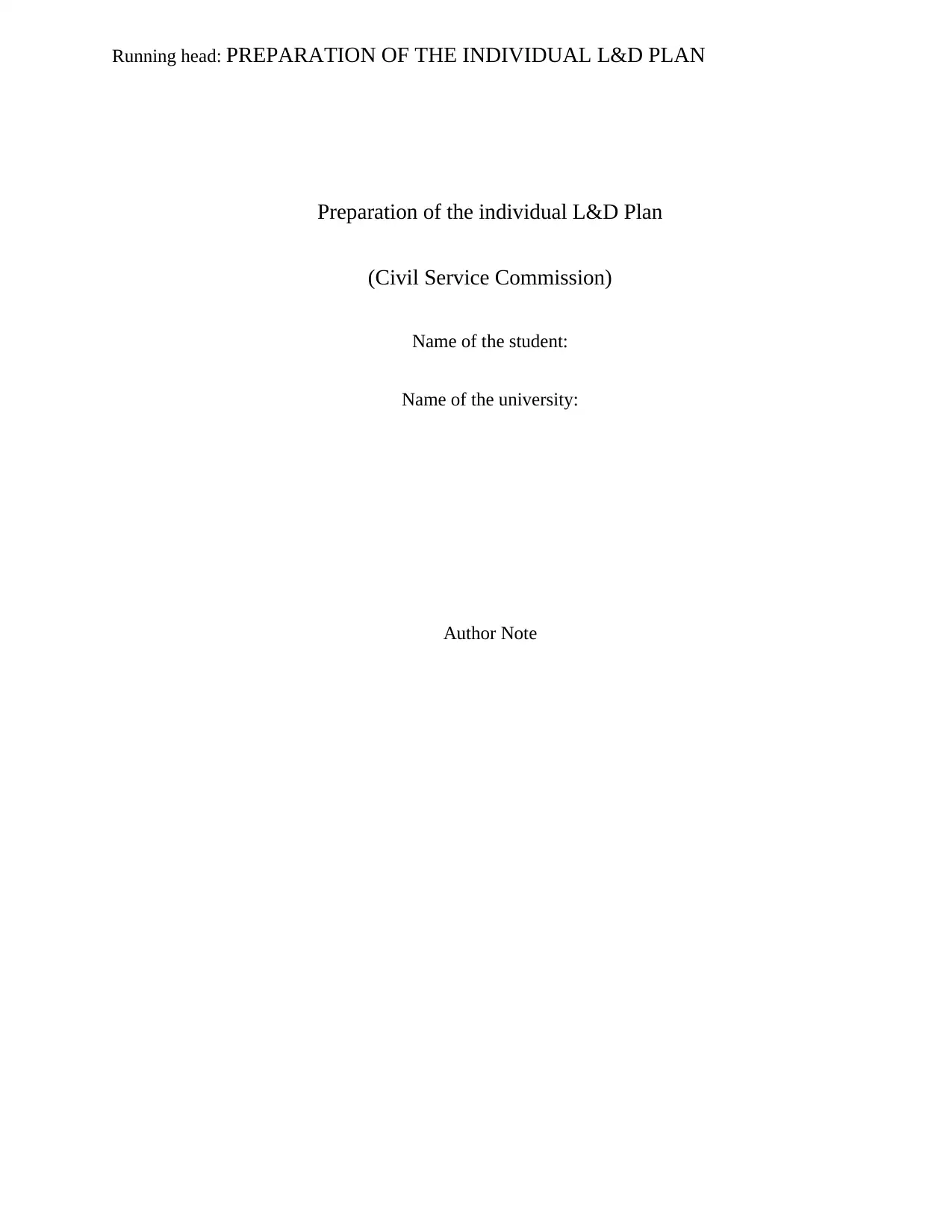
Running head: PREPARATION OF THE INDIVIDUAL L&D PLAN
Preparation of the individual L&D Plan
(Civil Service Commission)
Name of the student:
Name of the university:
Author Note
Preparation of the individual L&D Plan
(Civil Service Commission)
Name of the student:
Name of the university:
Author Note
Paraphrase This Document
Need a fresh take? Get an instant paraphrase of this document with our AI Paraphraser
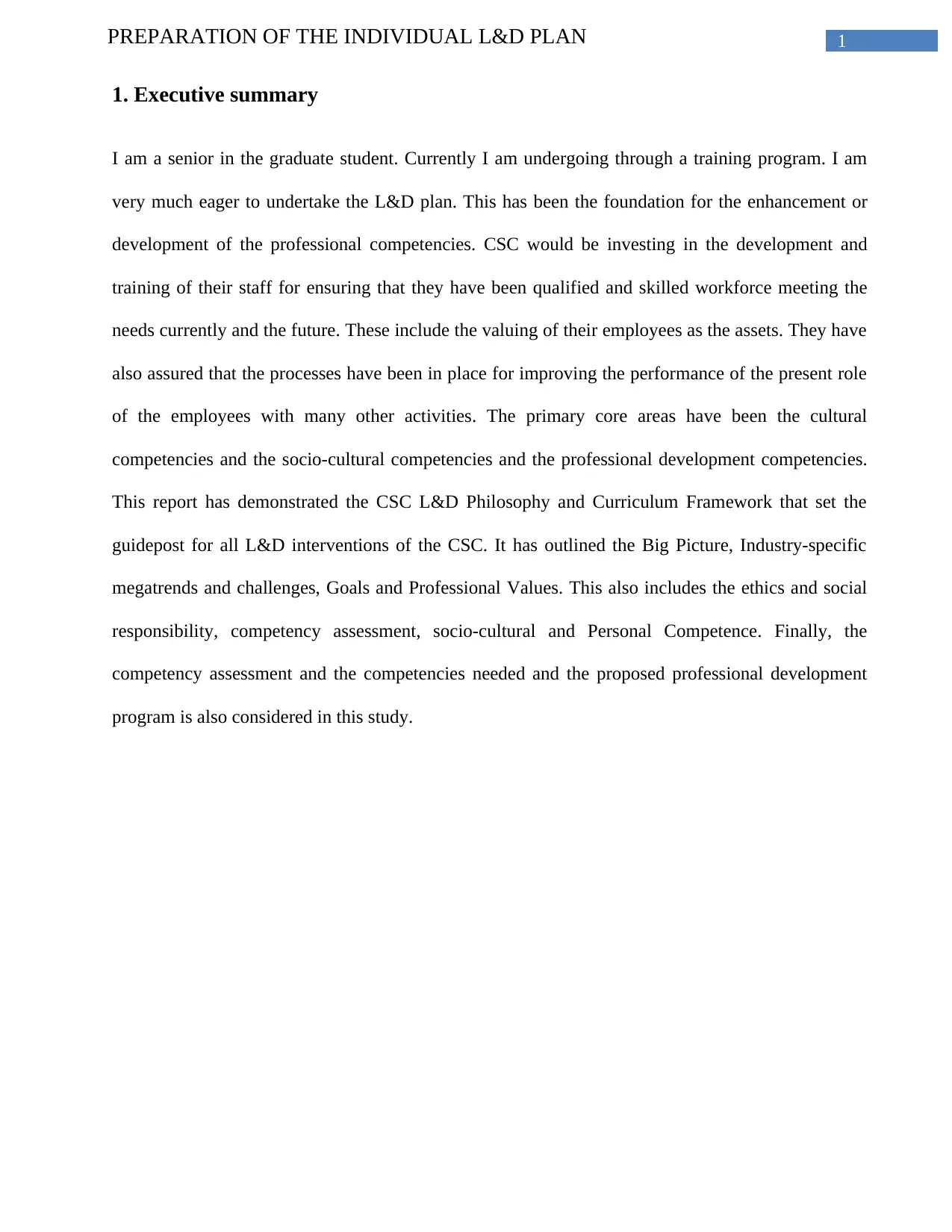
1PREPARATION OF THE INDIVIDUAL L&D PLAN
1. Executive summary
I am a senior in the graduate student. Currently I am undergoing through a training program. I am
very much eager to undertake the L&D plan. This has been the foundation for the enhancement or
development of the professional competencies. CSC would be investing in the development and
training of their staff for ensuring that they have been qualified and skilled workforce meeting the
needs currently and the future. These include the valuing of their employees as the assets. They have
also assured that the processes have been in place for improving the performance of the present role
of the employees with many other activities. The primary core areas have been the cultural
competencies and the socio-cultural competencies and the professional development competencies.
This report has demonstrated the CSC L&D Philosophy and Curriculum Framework that set the
guidepost for all L&D interventions of the CSC. It has outlined the Big Picture, Industry-specific
megatrends and challenges, Goals and Professional Values. This also includes the ethics and social
responsibility, competency assessment, socio-cultural and Personal Competence. Finally, the
competency assessment and the competencies needed and the proposed professional development
program is also considered in this study.
1. Executive summary
I am a senior in the graduate student. Currently I am undergoing through a training program. I am
very much eager to undertake the L&D plan. This has been the foundation for the enhancement or
development of the professional competencies. CSC would be investing in the development and
training of their staff for ensuring that they have been qualified and skilled workforce meeting the
needs currently and the future. These include the valuing of their employees as the assets. They have
also assured that the processes have been in place for improving the performance of the present role
of the employees with many other activities. The primary core areas have been the cultural
competencies and the socio-cultural competencies and the professional development competencies.
This report has demonstrated the CSC L&D Philosophy and Curriculum Framework that set the
guidepost for all L&D interventions of the CSC. It has outlined the Big Picture, Industry-specific
megatrends and challenges, Goals and Professional Values. This also includes the ethics and social
responsibility, competency assessment, socio-cultural and Personal Competence. Finally, the
competency assessment and the competencies needed and the proposed professional development
program is also considered in this study.
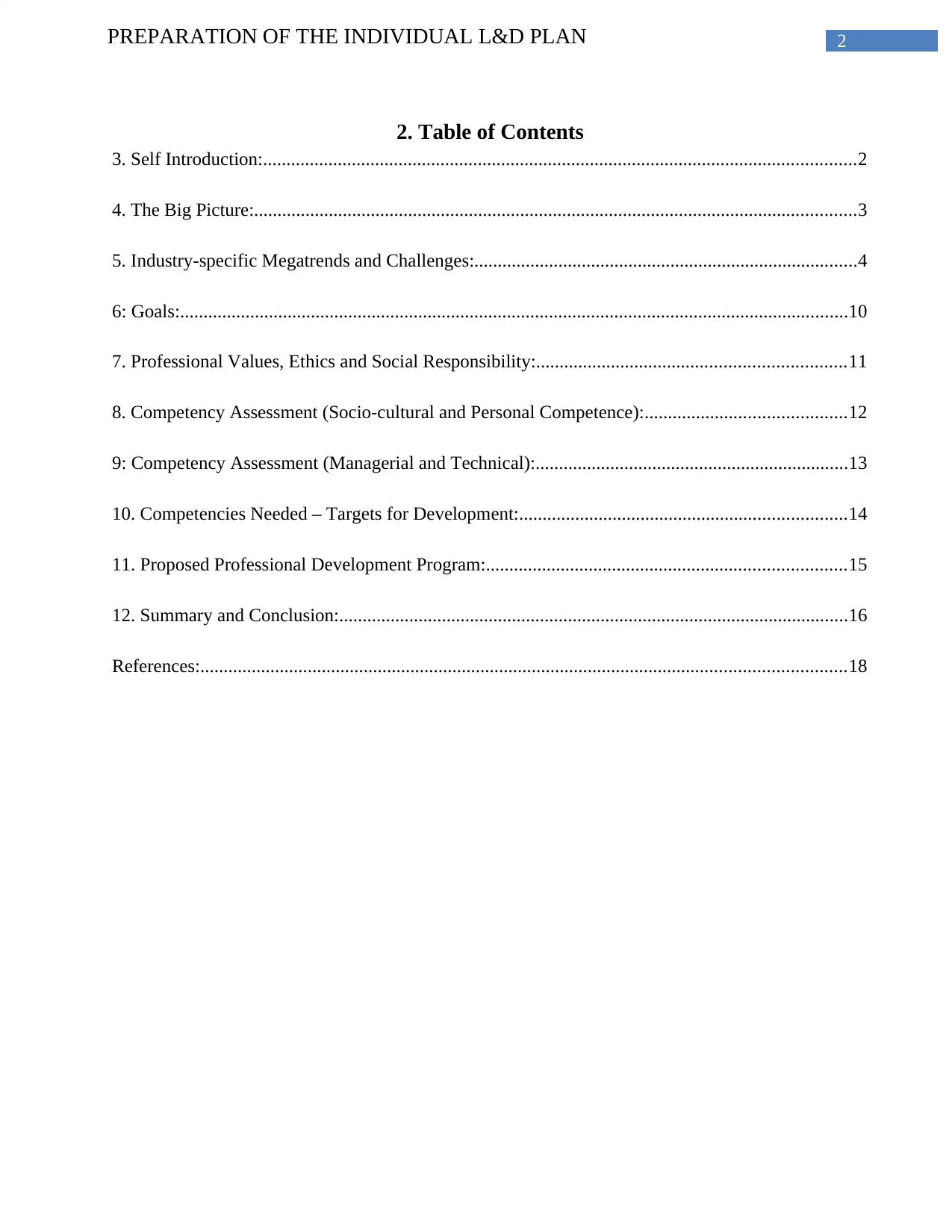
2PREPARATION OF THE INDIVIDUAL L&D PLAN
2. Table of Contents
3. Self Introduction:...............................................................................................................................2
4. The Big Picture:.................................................................................................................................3
5. Industry-specific Megatrends and Challenges:..................................................................................4
6: Goals:...............................................................................................................................................10
7. Professional Values, Ethics and Social Responsibility:..................................................................11
8. Competency Assessment (Socio-cultural and Personal Competence):...........................................12
9: Competency Assessment (Managerial and Technical):...................................................................13
10. Competencies Needed – Targets for Development:......................................................................14
11. Proposed Professional Development Program:.............................................................................15
12. Summary and Conclusion:.............................................................................................................16
References:..........................................................................................................................................18
2. Table of Contents
3. Self Introduction:...............................................................................................................................2
4. The Big Picture:.................................................................................................................................3
5. Industry-specific Megatrends and Challenges:..................................................................................4
6: Goals:...............................................................................................................................................10
7. Professional Values, Ethics and Social Responsibility:..................................................................11
8. Competency Assessment (Socio-cultural and Personal Competence):...........................................12
9: Competency Assessment (Managerial and Technical):...................................................................13
10. Competencies Needed – Targets for Development:......................................................................14
11. Proposed Professional Development Program:.............................................................................15
12. Summary and Conclusion:.............................................................................................................16
References:..........................................................................................................................................18
⊘ This is a preview!⊘
Do you want full access?
Subscribe today to unlock all pages.

Trusted by 1+ million students worldwide
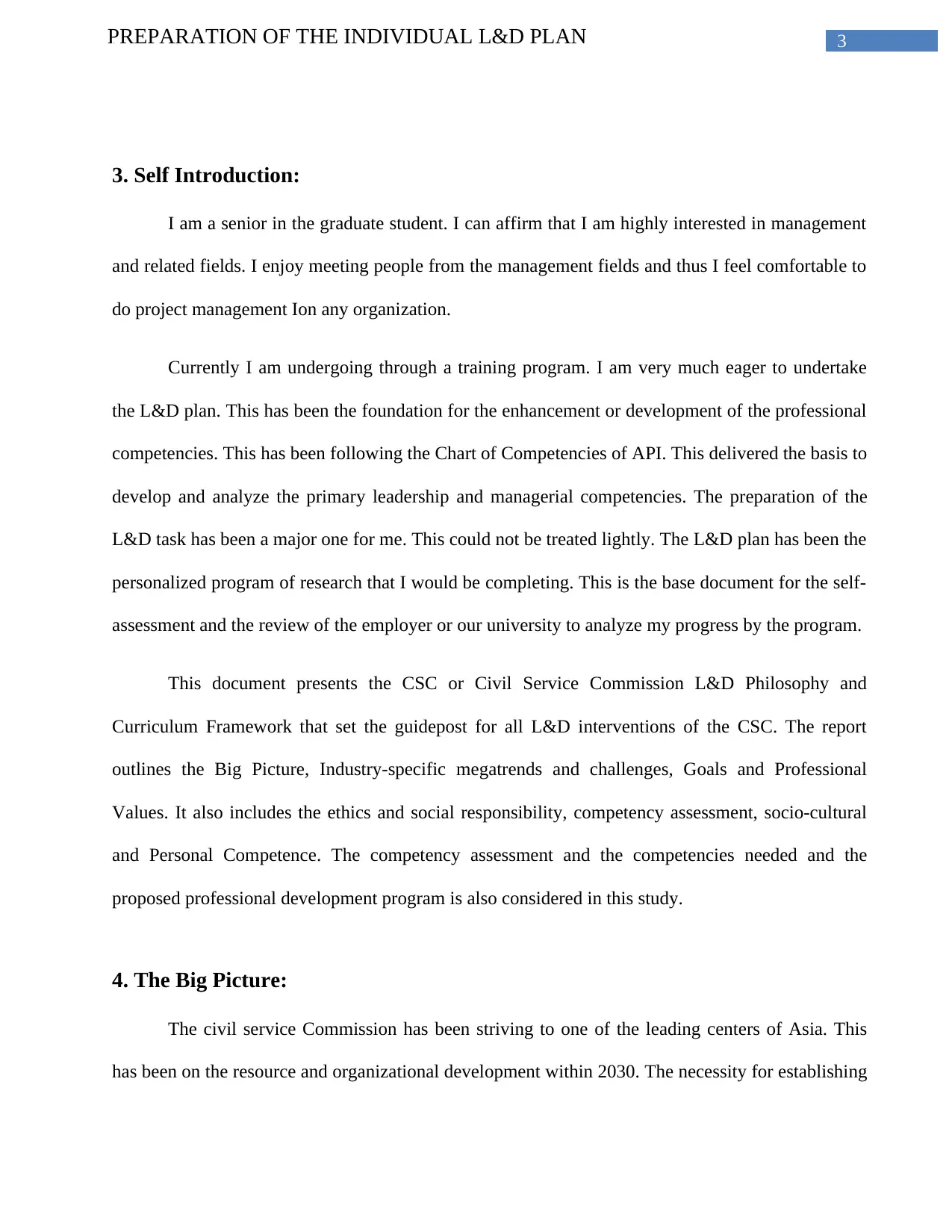
3PREPARATION OF THE INDIVIDUAL L&D PLAN
3. Self Introduction:
I am a senior in the graduate student. I can affirm that I am highly interested in management
and related fields. I enjoy meeting people from the management fields and thus I feel comfortable to
do project management Ion any organization.
Currently I am undergoing through a training program. I am very much eager to undertake
the L&D plan. This has been the foundation for the enhancement or development of the professional
competencies. This has been following the Chart of Competencies of API. This delivered the basis to
develop and analyze the primary leadership and managerial competencies. The preparation of the
L&D task has been a major one for me. This could not be treated lightly. The L&D plan has been the
personalized program of research that I would be completing. This is the base document for the self-
assessment and the review of the employer or our university to analyze my progress by the program.
This document presents the CSC or Civil Service Commission L&D Philosophy and
Curriculum Framework that set the guidepost for all L&D interventions of the CSC. The report
outlines the Big Picture, Industry-specific megatrends and challenges, Goals and Professional
Values. It also includes the ethics and social responsibility, competency assessment, socio-cultural
and Personal Competence. The competency assessment and the competencies needed and the
proposed professional development program is also considered in this study.
4. The Big Picture:
The civil service Commission has been striving to one of the leading centers of Asia. This
has been on the resource and organizational development within 2030. The necessity for establishing
3. Self Introduction:
I am a senior in the graduate student. I can affirm that I am highly interested in management
and related fields. I enjoy meeting people from the management fields and thus I feel comfortable to
do project management Ion any organization.
Currently I am undergoing through a training program. I am very much eager to undertake
the L&D plan. This has been the foundation for the enhancement or development of the professional
competencies. This has been following the Chart of Competencies of API. This delivered the basis to
develop and analyze the primary leadership and managerial competencies. The preparation of the
L&D task has been a major one for me. This could not be treated lightly. The L&D plan has been the
personalized program of research that I would be completing. This is the base document for the self-
assessment and the review of the employer or our university to analyze my progress by the program.
This document presents the CSC or Civil Service Commission L&D Philosophy and
Curriculum Framework that set the guidepost for all L&D interventions of the CSC. The report
outlines the Big Picture, Industry-specific megatrends and challenges, Goals and Professional
Values. It also includes the ethics and social responsibility, competency assessment, socio-cultural
and Personal Competence. The competency assessment and the competencies needed and the
proposed professional development program is also considered in this study.
4. The Big Picture:
The civil service Commission has been striving to one of the leading centers of Asia. This
has been on the resource and organizational development within 2030. The necessity for establishing
Paraphrase This Document
Need a fresh take? Get an instant paraphrase of this document with our AI Paraphraser
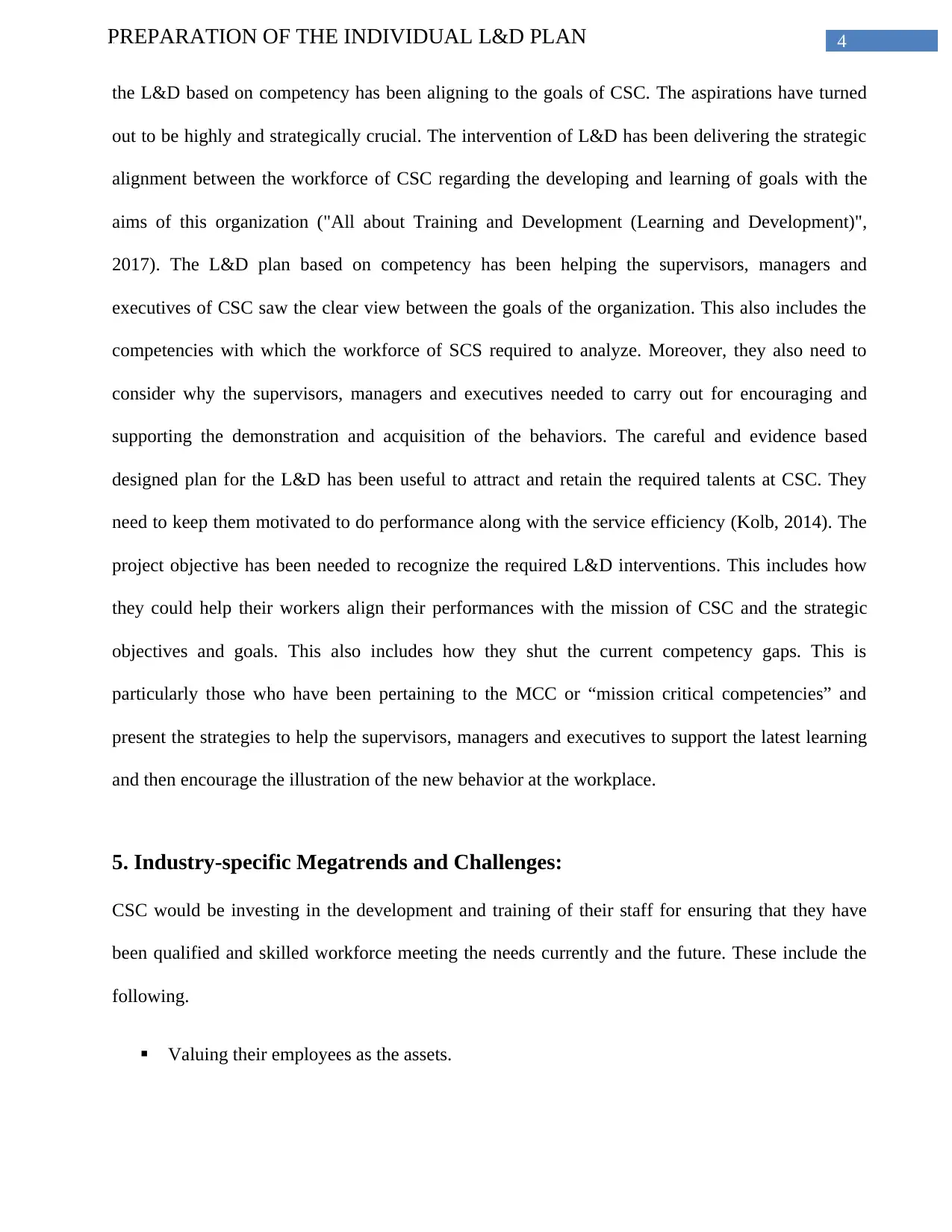
4PREPARATION OF THE INDIVIDUAL L&D PLAN
the L&D based on competency has been aligning to the goals of CSC. The aspirations have turned
out to be highly and strategically crucial. The intervention of L&D has been delivering the strategic
alignment between the workforce of CSC regarding the developing and learning of goals with the
aims of this organization ("All about Training and Development (Learning and Development)",
2017). The L&D plan based on competency has been helping the supervisors, managers and
executives of CSC saw the clear view between the goals of the organization. This also includes the
competencies with which the workforce of SCS required to analyze. Moreover, they also need to
consider why the supervisors, managers and executives needed to carry out for encouraging and
supporting the demonstration and acquisition of the behaviors. The careful and evidence based
designed plan for the L&D has been useful to attract and retain the required talents at CSC. They
need to keep them motivated to do performance along with the service efficiency (Kolb, 2014). The
project objective has been needed to recognize the required L&D interventions. This includes how
they could help their workers align their performances with the mission of CSC and the strategic
objectives and goals. This also includes how they shut the current competency gaps. This is
particularly those who have been pertaining to the MCC or “mission critical competencies” and
present the strategies to help the supervisors, managers and executives to support the latest learning
and then encourage the illustration of the new behavior at the workplace.
5. Industry-specific Megatrends and Challenges:
CSC would be investing in the development and training of their staff for ensuring that they have
been qualified and skilled workforce meeting the needs currently and the future. These include the
following.
Valuing their employees as the assets.
the L&D based on competency has been aligning to the goals of CSC. The aspirations have turned
out to be highly and strategically crucial. The intervention of L&D has been delivering the strategic
alignment between the workforce of CSC regarding the developing and learning of goals with the
aims of this organization ("All about Training and Development (Learning and Development)",
2017). The L&D plan based on competency has been helping the supervisors, managers and
executives of CSC saw the clear view between the goals of the organization. This also includes the
competencies with which the workforce of SCS required to analyze. Moreover, they also need to
consider why the supervisors, managers and executives needed to carry out for encouraging and
supporting the demonstration and acquisition of the behaviors. The careful and evidence based
designed plan for the L&D has been useful to attract and retain the required talents at CSC. They
need to keep them motivated to do performance along with the service efficiency (Kolb, 2014). The
project objective has been needed to recognize the required L&D interventions. This includes how
they could help their workers align their performances with the mission of CSC and the strategic
objectives and goals. This also includes how they shut the current competency gaps. This is
particularly those who have been pertaining to the MCC or “mission critical competencies” and
present the strategies to help the supervisors, managers and executives to support the latest learning
and then encourage the illustration of the new behavior at the workplace.
5. Industry-specific Megatrends and Challenges:
CSC would be investing in the development and training of their staff for ensuring that they have
been qualified and skilled workforce meeting the needs currently and the future. These include the
following.
Valuing their employees as the assets.
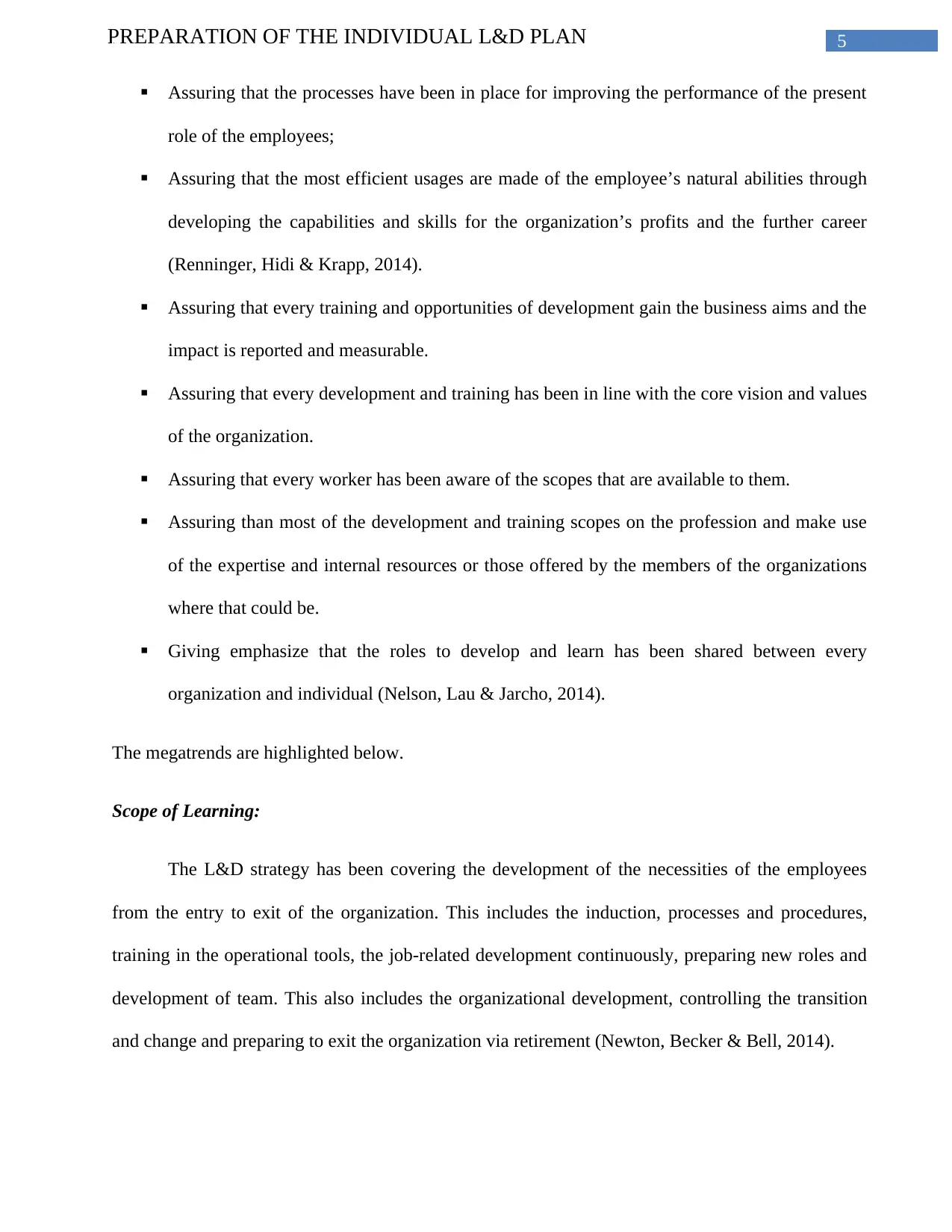
5PREPARATION OF THE INDIVIDUAL L&D PLAN
Assuring that the processes have been in place for improving the performance of the present
role of the employees;
Assuring that the most efficient usages are made of the employee’s natural abilities through
developing the capabilities and skills for the organization’s profits and the further career
(Renninger, Hidi & Krapp, 2014).
Assuring that every training and opportunities of development gain the business aims and the
impact is reported and measurable.
Assuring that every development and training has been in line with the core vision and values
of the organization.
Assuring that every worker has been aware of the scopes that are available to them.
Assuring than most of the development and training scopes on the profession and make use
of the expertise and internal resources or those offered by the members of the organizations
where that could be.
Giving emphasize that the roles to develop and learn has been shared between every
organization and individual (Nelson, Lau & Jarcho, 2014).
The megatrends are highlighted below.
Scope of Learning:
The L&D strategy has been covering the development of the necessities of the employees
from the entry to exit of the organization. This includes the induction, processes and procedures,
training in the operational tools, the job-related development continuously, preparing new roles and
development of team. This also includes the organizational development, controlling the transition
and change and preparing to exit the organization via retirement (Newton, Becker & Bell, 2014).
Assuring that the processes have been in place for improving the performance of the present
role of the employees;
Assuring that the most efficient usages are made of the employee’s natural abilities through
developing the capabilities and skills for the organization’s profits and the further career
(Renninger, Hidi & Krapp, 2014).
Assuring that every training and opportunities of development gain the business aims and the
impact is reported and measurable.
Assuring that every development and training has been in line with the core vision and values
of the organization.
Assuring that every worker has been aware of the scopes that are available to them.
Assuring than most of the development and training scopes on the profession and make use
of the expertise and internal resources or those offered by the members of the organizations
where that could be.
Giving emphasize that the roles to develop and learn has been shared between every
organization and individual (Nelson, Lau & Jarcho, 2014).
The megatrends are highlighted below.
Scope of Learning:
The L&D strategy has been covering the development of the necessities of the employees
from the entry to exit of the organization. This includes the induction, processes and procedures,
training in the operational tools, the job-related development continuously, preparing new roles and
development of team. This also includes the organizational development, controlling the transition
and change and preparing to exit the organization via retirement (Newton, Becker & Bell, 2014).
⊘ This is a preview!⊘
Do you want full access?
Subscribe today to unlock all pages.

Trusted by 1+ million students worldwide
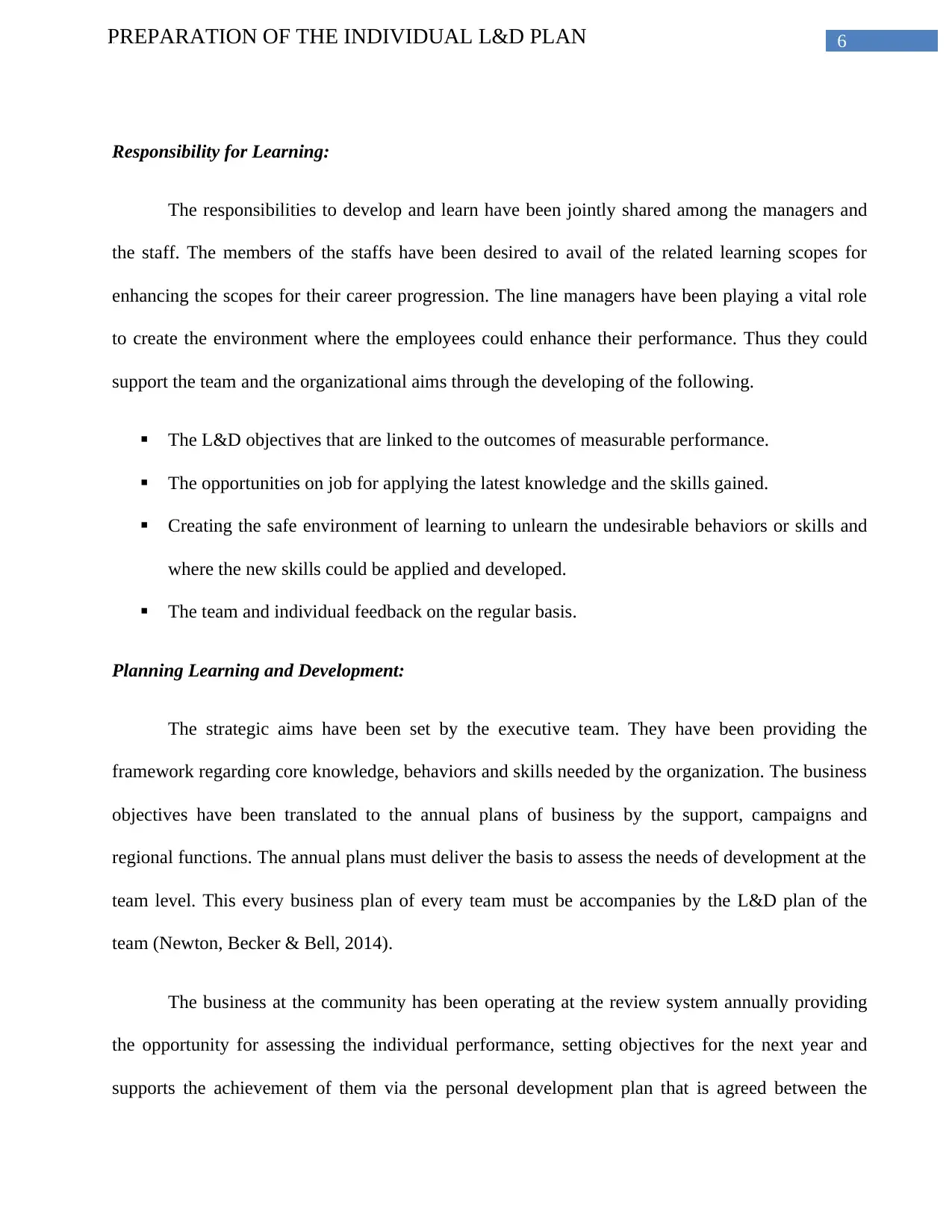
6PREPARATION OF THE INDIVIDUAL L&D PLAN
Responsibility for Learning:
The responsibilities to develop and learn have been jointly shared among the managers and
the staff. The members of the staffs have been desired to avail of the related learning scopes for
enhancing the scopes for their career progression. The line managers have been playing a vital role
to create the environment where the employees could enhance their performance. Thus they could
support the team and the organizational aims through the developing of the following.
The L&D objectives that are linked to the outcomes of measurable performance.
The opportunities on job for applying the latest knowledge and the skills gained.
Creating the safe environment of learning to unlearn the undesirable behaviors or skills and
where the new skills could be applied and developed.
The team and individual feedback on the regular basis.
Planning Learning and Development:
The strategic aims have been set by the executive team. They have been providing the
framework regarding core knowledge, behaviors and skills needed by the organization. The business
objectives have been translated to the annual plans of business by the support, campaigns and
regional functions. The annual plans must deliver the basis to assess the needs of development at the
team level. This every business plan of every team must be accompanies by the L&D plan of the
team (Newton, Becker & Bell, 2014).
The business at the community has been operating at the review system annually providing
the opportunity for assessing the individual performance, setting objectives for the next year and
supports the achievement of them via the personal development plan that is agreed between the
Responsibility for Learning:
The responsibilities to develop and learn have been jointly shared among the managers and
the staff. The members of the staffs have been desired to avail of the related learning scopes for
enhancing the scopes for their career progression. The line managers have been playing a vital role
to create the environment where the employees could enhance their performance. Thus they could
support the team and the organizational aims through the developing of the following.
The L&D objectives that are linked to the outcomes of measurable performance.
The opportunities on job for applying the latest knowledge and the skills gained.
Creating the safe environment of learning to unlearn the undesirable behaviors or skills and
where the new skills could be applied and developed.
The team and individual feedback on the regular basis.
Planning Learning and Development:
The strategic aims have been set by the executive team. They have been providing the
framework regarding core knowledge, behaviors and skills needed by the organization. The business
objectives have been translated to the annual plans of business by the support, campaigns and
regional functions. The annual plans must deliver the basis to assess the needs of development at the
team level. This every business plan of every team must be accompanies by the L&D plan of the
team (Newton, Becker & Bell, 2014).
The business at the community has been operating at the review system annually providing
the opportunity for assessing the individual performance, setting objectives for the next year and
supports the achievement of them via the personal development plan that is agreed between the
Paraphrase This Document
Need a fresh take? Get an instant paraphrase of this document with our AI Paraphraser
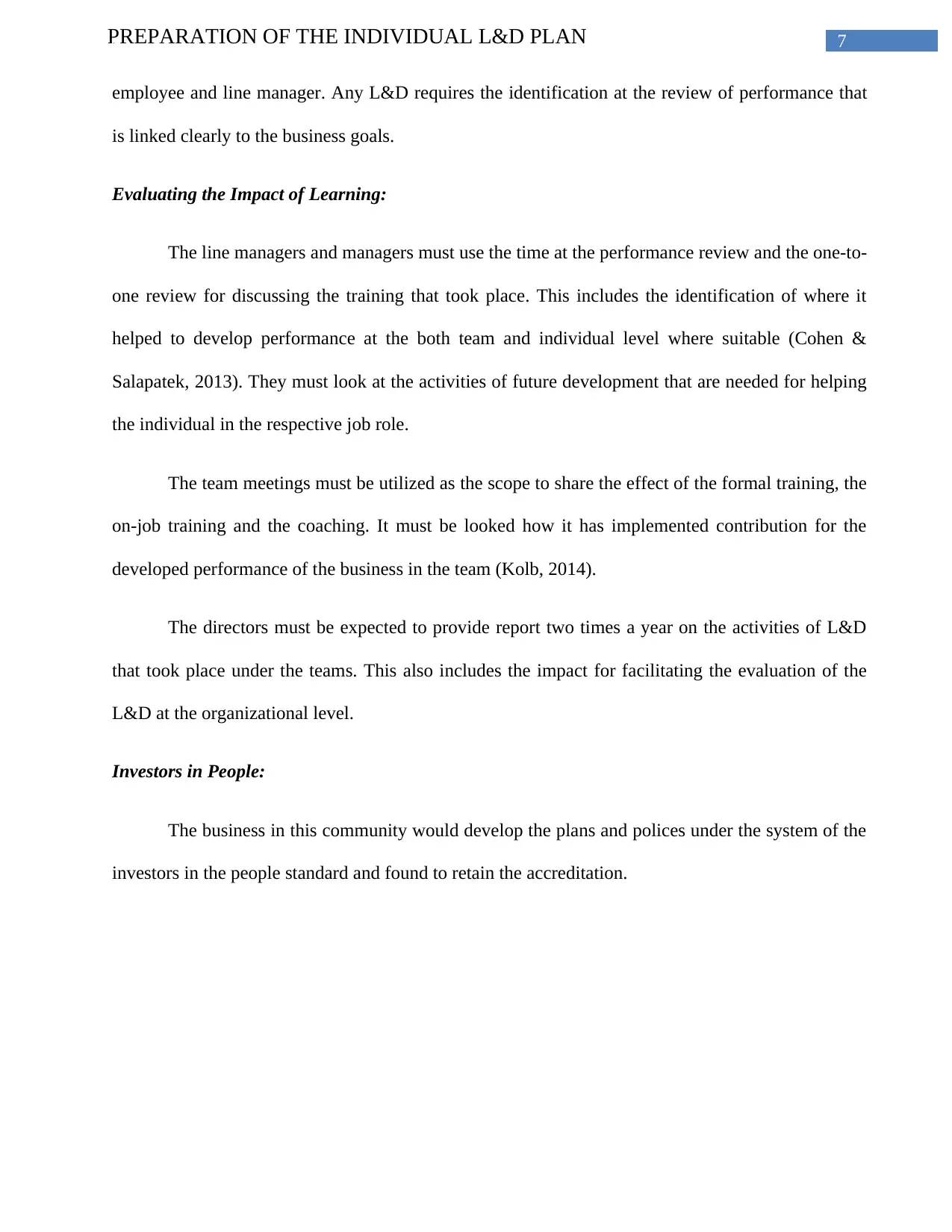
7PREPARATION OF THE INDIVIDUAL L&D PLAN
employee and line manager. Any L&D requires the identification at the review of performance that
is linked clearly to the business goals.
Evaluating the Impact of Learning:
The line managers and managers must use the time at the performance review and the one-to-
one review for discussing the training that took place. This includes the identification of where it
helped to develop performance at the both team and individual level where suitable (Cohen &
Salapatek, 2013). They must look at the activities of future development that are needed for helping
the individual in the respective job role.
The team meetings must be utilized as the scope to share the effect of the formal training, the
on-job training and the coaching. It must be looked how it has implemented contribution for the
developed performance of the business in the team (Kolb, 2014).
The directors must be expected to provide report two times a year on the activities of L&D
that took place under the teams. This also includes the impact for facilitating the evaluation of the
L&D at the organizational level.
Investors in People:
The business in this community would develop the plans and polices under the system of the
investors in the people standard and found to retain the accreditation.
employee and line manager. Any L&D requires the identification at the review of performance that
is linked clearly to the business goals.
Evaluating the Impact of Learning:
The line managers and managers must use the time at the performance review and the one-to-
one review for discussing the training that took place. This includes the identification of where it
helped to develop performance at the both team and individual level where suitable (Cohen &
Salapatek, 2013). They must look at the activities of future development that are needed for helping
the individual in the respective job role.
The team meetings must be utilized as the scope to share the effect of the formal training, the
on-job training and the coaching. It must be looked how it has implemented contribution for the
developed performance of the business in the team (Kolb, 2014).
The directors must be expected to provide report two times a year on the activities of L&D
that took place under the teams. This also includes the impact for facilitating the evaluation of the
L&D at the organizational level.
Investors in People:
The business in this community would develop the plans and polices under the system of the
investors in the people standard and found to retain the accreditation.
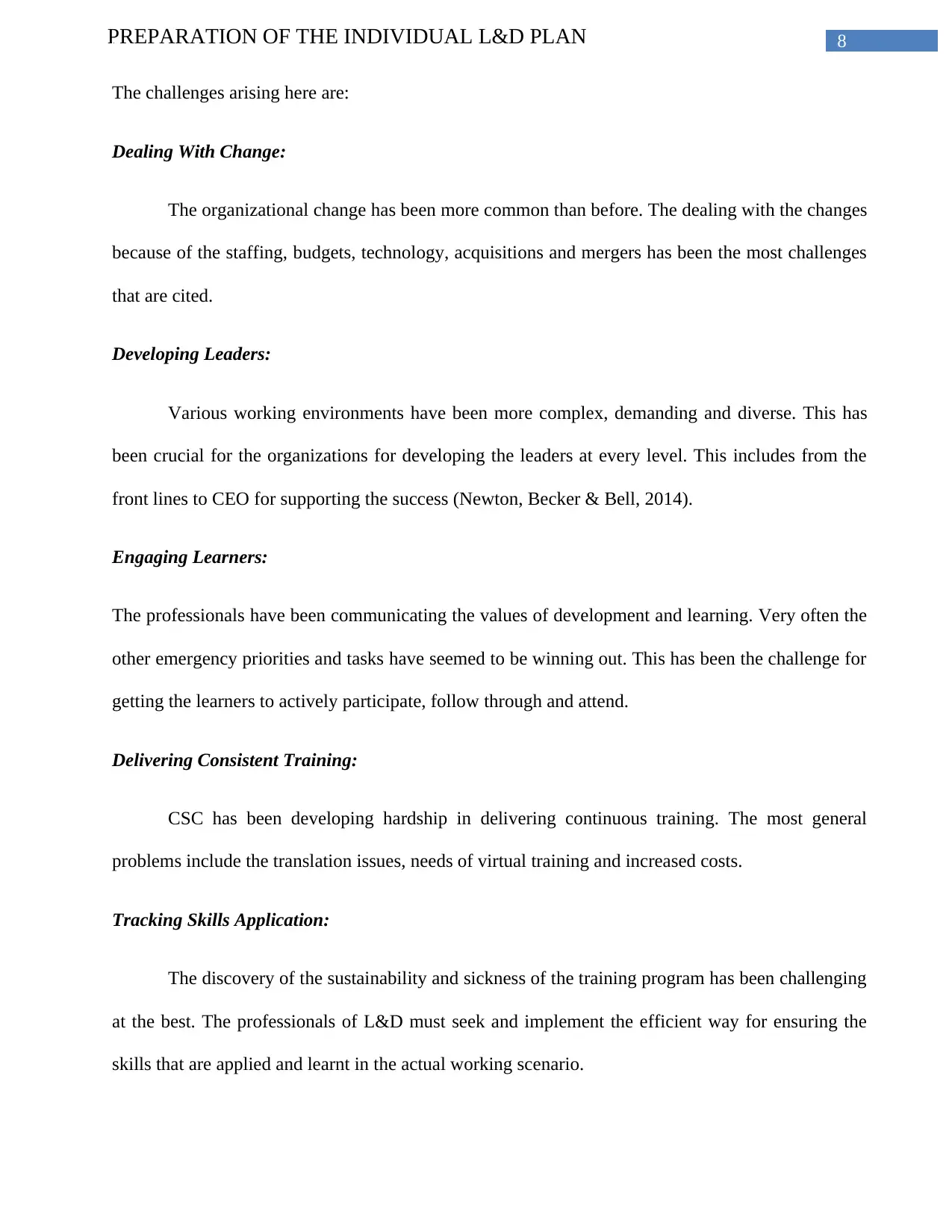
8PREPARATION OF THE INDIVIDUAL L&D PLAN
The challenges arising here are:
Dealing With Change:
The organizational change has been more common than before. The dealing with the changes
because of the staffing, budgets, technology, acquisitions and mergers has been the most challenges
that are cited.
Developing Leaders:
Various working environments have been more complex, demanding and diverse. This has
been crucial for the organizations for developing the leaders at every level. This includes from the
front lines to CEO for supporting the success (Newton, Becker & Bell, 2014).
Engaging Learners:
The professionals have been communicating the values of development and learning. Very often the
other emergency priorities and tasks have seemed to be winning out. This has been the challenge for
getting the learners to actively participate, follow through and attend.
Delivering Consistent Training:
CSC has been developing hardship in delivering continuous training. The most general
problems include the translation issues, needs of virtual training and increased costs.
Tracking Skills Application:
The discovery of the sustainability and sickness of the training program has been challenging
at the best. The professionals of L&D must seek and implement the efficient way for ensuring the
skills that are applied and learnt in the actual working scenario.
The challenges arising here are:
Dealing With Change:
The organizational change has been more common than before. The dealing with the changes
because of the staffing, budgets, technology, acquisitions and mergers has been the most challenges
that are cited.
Developing Leaders:
Various working environments have been more complex, demanding and diverse. This has
been crucial for the organizations for developing the leaders at every level. This includes from the
front lines to CEO for supporting the success (Newton, Becker & Bell, 2014).
Engaging Learners:
The professionals have been communicating the values of development and learning. Very often the
other emergency priorities and tasks have seemed to be winning out. This has been the challenge for
getting the learners to actively participate, follow through and attend.
Delivering Consistent Training:
CSC has been developing hardship in delivering continuous training. The most general
problems include the translation issues, needs of virtual training and increased costs.
Tracking Skills Application:
The discovery of the sustainability and sickness of the training program has been challenging
at the best. The professionals of L&D must seek and implement the efficient way for ensuring the
skills that are applied and learnt in the actual working scenario.
⊘ This is a preview!⊘
Do you want full access?
Subscribe today to unlock all pages.

Trusted by 1+ million students worldwide
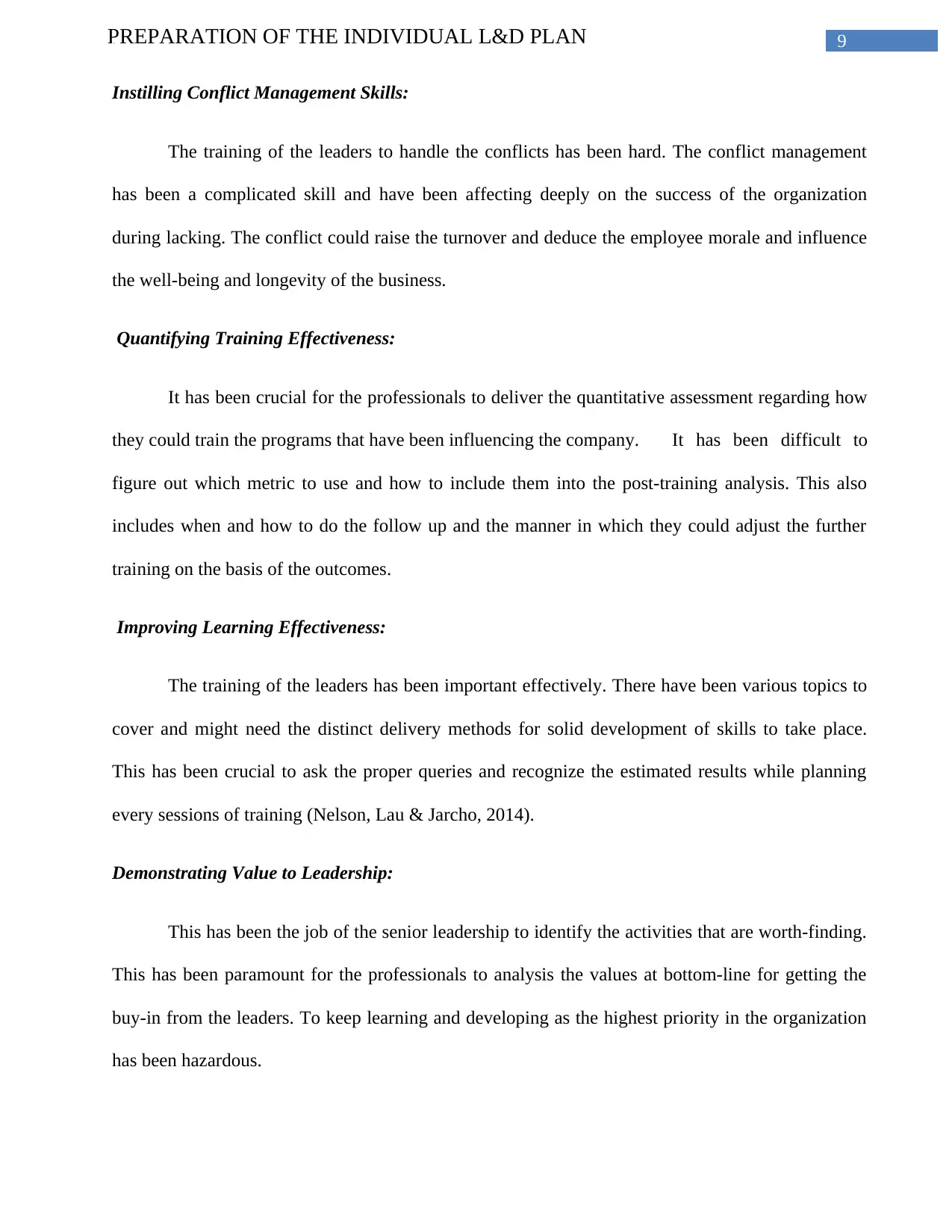
9PREPARATION OF THE INDIVIDUAL L&D PLAN
Instilling Conflict Management Skills:
The training of the leaders to handle the conflicts has been hard. The conflict management
has been a complicated skill and have been affecting deeply on the success of the organization
during lacking. The conflict could raise the turnover and deduce the employee morale and influence
the well-being and longevity of the business.
Quantifying Training Effectiveness:
It has been crucial for the professionals to deliver the quantitative assessment regarding how
they could train the programs that have been influencing the company. It has been difficult to
figure out which metric to use and how to include them into the post-training analysis. This also
includes when and how to do the follow up and the manner in which they could adjust the further
training on the basis of the outcomes.
Improving Learning Effectiveness:
The training of the leaders has been important effectively. There have been various topics to
cover and might need the distinct delivery methods for solid development of skills to take place.
This has been crucial to ask the proper queries and recognize the estimated results while planning
every sessions of training (Nelson, Lau & Jarcho, 2014).
Demonstrating Value to Leadership:
This has been the job of the senior leadership to identify the activities that are worth-finding.
This has been paramount for the professionals to analysis the values at bottom-line for getting the
buy-in from the leaders. To keep learning and developing as the highest priority in the organization
has been hazardous.
Instilling Conflict Management Skills:
The training of the leaders to handle the conflicts has been hard. The conflict management
has been a complicated skill and have been affecting deeply on the success of the organization
during lacking. The conflict could raise the turnover and deduce the employee morale and influence
the well-being and longevity of the business.
Quantifying Training Effectiveness:
It has been crucial for the professionals to deliver the quantitative assessment regarding how
they could train the programs that have been influencing the company. It has been difficult to
figure out which metric to use and how to include them into the post-training analysis. This also
includes when and how to do the follow up and the manner in which they could adjust the further
training on the basis of the outcomes.
Improving Learning Effectiveness:
The training of the leaders has been important effectively. There have been various topics to
cover and might need the distinct delivery methods for solid development of skills to take place.
This has been crucial to ask the proper queries and recognize the estimated results while planning
every sessions of training (Nelson, Lau & Jarcho, 2014).
Demonstrating Value to Leadership:
This has been the job of the senior leadership to identify the activities that are worth-finding.
This has been paramount for the professionals to analysis the values at bottom-line for getting the
buy-in from the leaders. To keep learning and developing as the highest priority in the organization
has been hazardous.
Paraphrase This Document
Need a fresh take? Get an instant paraphrase of this document with our AI Paraphraser
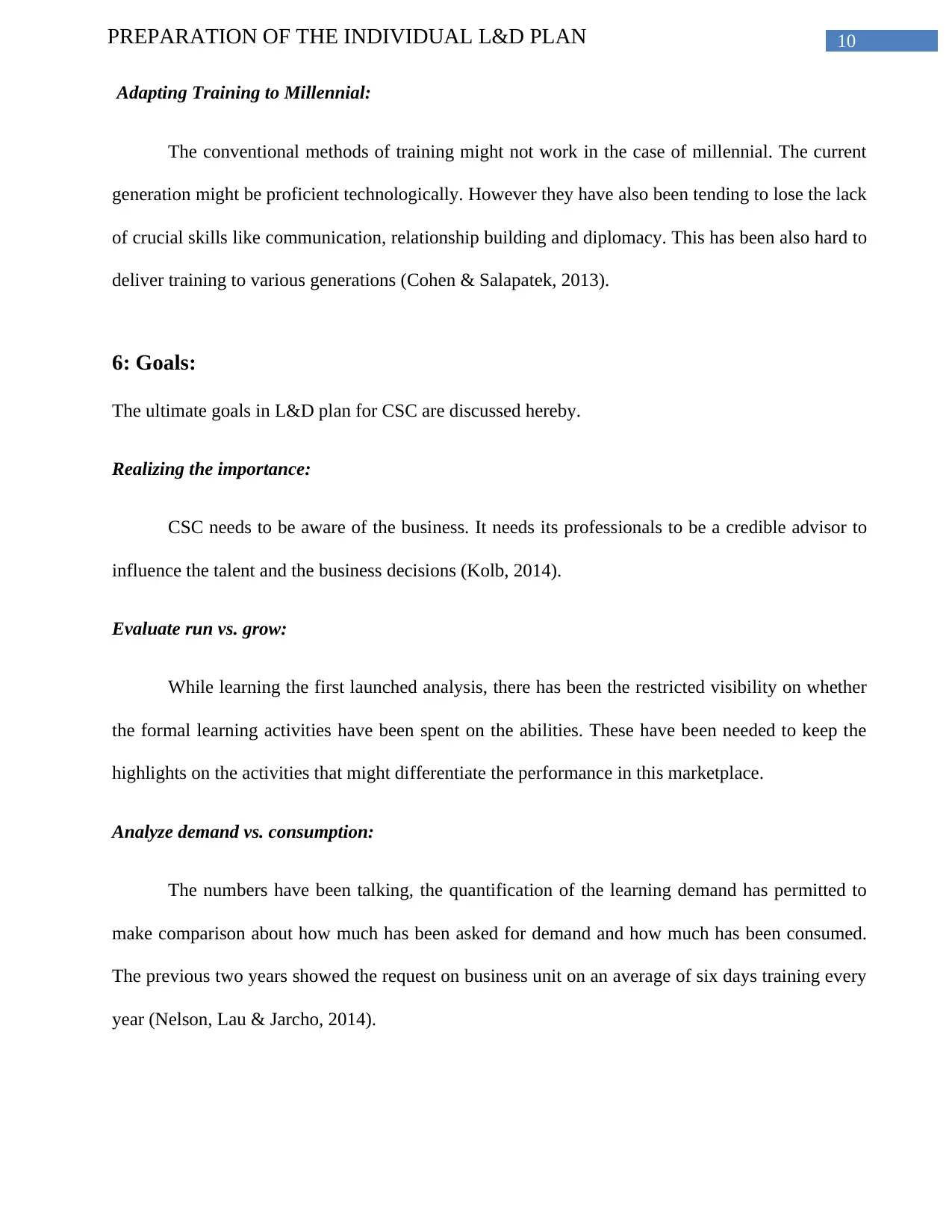
10PREPARATION OF THE INDIVIDUAL L&D PLAN
Adapting Training to Millennial:
The conventional methods of training might not work in the case of millennial. The current
generation might be proficient technologically. However they have also been tending to lose the lack
of crucial skills like communication, relationship building and diplomacy. This has been also hard to
deliver training to various generations (Cohen & Salapatek, 2013).
6: Goals:
The ultimate goals in L&D plan for CSC are discussed hereby.
Realizing the importance:
CSC needs to be aware of the business. It needs its professionals to be a credible advisor to
influence the talent and the business decisions (Kolb, 2014).
Evaluate run vs. grow:
While learning the first launched analysis, there has been the restricted visibility on whether
the formal learning activities have been spent on the abilities. These have been needed to keep the
highlights on the activities that might differentiate the performance in this marketplace.
Analyze demand vs. consumption:
The numbers have been talking, the quantification of the learning demand has permitted to
make comparison about how much has been asked for demand and how much has been consumed.
The previous two years showed the request on business unit on an average of six days training every
year (Nelson, Lau & Jarcho, 2014).
Adapting Training to Millennial:
The conventional methods of training might not work in the case of millennial. The current
generation might be proficient technologically. However they have also been tending to lose the lack
of crucial skills like communication, relationship building and diplomacy. This has been also hard to
deliver training to various generations (Cohen & Salapatek, 2013).
6: Goals:
The ultimate goals in L&D plan for CSC are discussed hereby.
Realizing the importance:
CSC needs to be aware of the business. It needs its professionals to be a credible advisor to
influence the talent and the business decisions (Kolb, 2014).
Evaluate run vs. grow:
While learning the first launched analysis, there has been the restricted visibility on whether
the formal learning activities have been spent on the abilities. These have been needed to keep the
highlights on the activities that might differentiate the performance in this marketplace.
Analyze demand vs. consumption:
The numbers have been talking, the quantification of the learning demand has permitted to
make comparison about how much has been asked for demand and how much has been consumed.
The previous two years showed the request on business unit on an average of six days training every
year (Nelson, Lau & Jarcho, 2014).
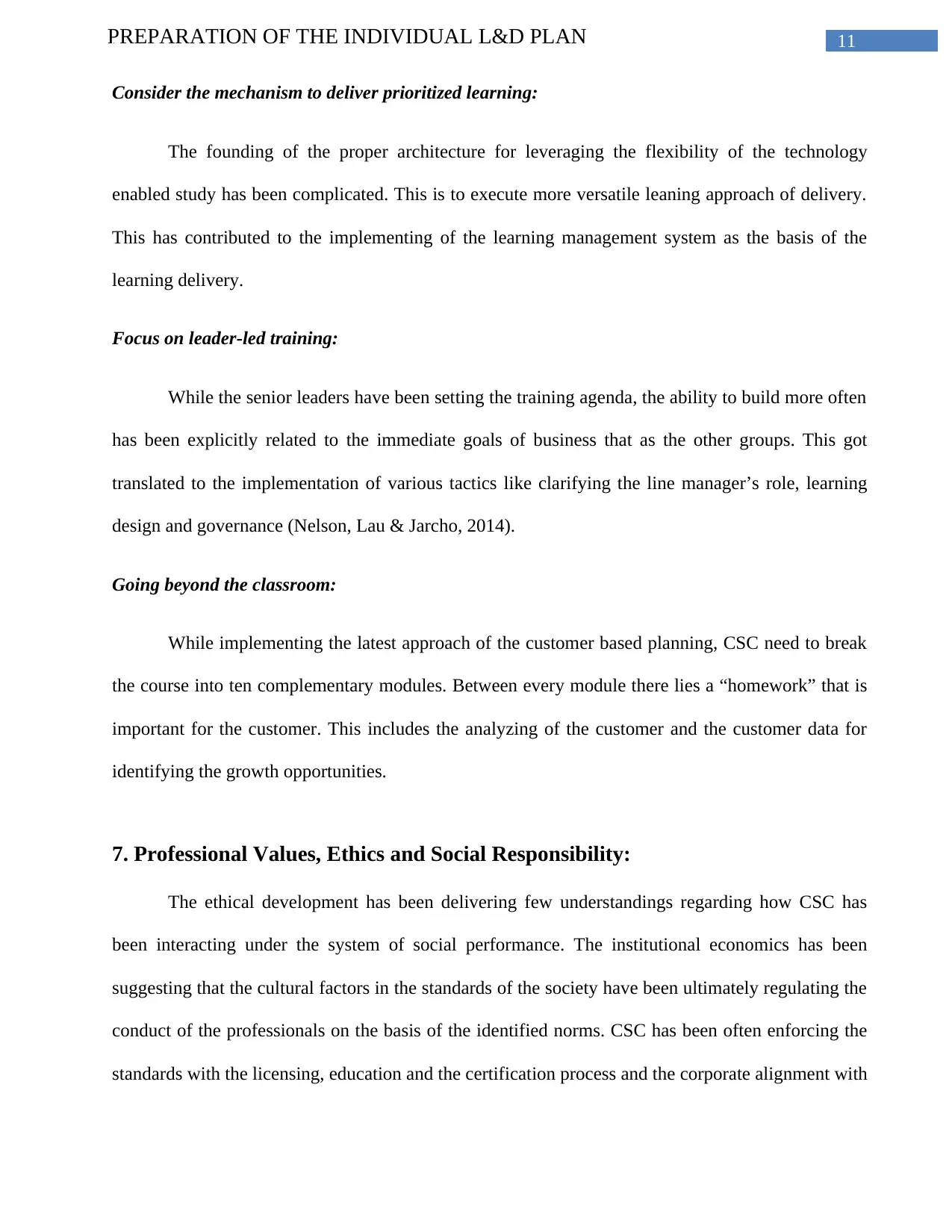
11PREPARATION OF THE INDIVIDUAL L&D PLAN
Consider the mechanism to deliver prioritized learning:
The founding of the proper architecture for leveraging the flexibility of the technology
enabled study has been complicated. This is to execute more versatile leaning approach of delivery.
This has contributed to the implementing of the learning management system as the basis of the
learning delivery.
Focus on leader-led training:
While the senior leaders have been setting the training agenda, the ability to build more often
has been explicitly related to the immediate goals of business that as the other groups. This got
translated to the implementation of various tactics like clarifying the line manager’s role, learning
design and governance (Nelson, Lau & Jarcho, 2014).
Going beyond the classroom:
While implementing the latest approach of the customer based planning, CSC need to break
the course into ten complementary modules. Between every module there lies a “homework” that is
important for the customer. This includes the analyzing of the customer and the customer data for
identifying the growth opportunities.
7. Professional Values, Ethics and Social Responsibility:
The ethical development has been delivering few understandings regarding how CSC has
been interacting under the system of social performance. The institutional economics has been
suggesting that the cultural factors in the standards of the society have been ultimately regulating the
conduct of the professionals on the basis of the identified norms. CSC has been often enforcing the
standards with the licensing, education and the certification process and the corporate alignment with
Consider the mechanism to deliver prioritized learning:
The founding of the proper architecture for leveraging the flexibility of the technology
enabled study has been complicated. This is to execute more versatile leaning approach of delivery.
This has contributed to the implementing of the learning management system as the basis of the
learning delivery.
Focus on leader-led training:
While the senior leaders have been setting the training agenda, the ability to build more often
has been explicitly related to the immediate goals of business that as the other groups. This got
translated to the implementation of various tactics like clarifying the line manager’s role, learning
design and governance (Nelson, Lau & Jarcho, 2014).
Going beyond the classroom:
While implementing the latest approach of the customer based planning, CSC need to break
the course into ten complementary modules. Between every module there lies a “homework” that is
important for the customer. This includes the analyzing of the customer and the customer data for
identifying the growth opportunities.
7. Professional Values, Ethics and Social Responsibility:
The ethical development has been delivering few understandings regarding how CSC has
been interacting under the system of social performance. The institutional economics has been
suggesting that the cultural factors in the standards of the society have been ultimately regulating the
conduct of the professionals on the basis of the identified norms. CSC has been often enforcing the
standards with the licensing, education and the certification process and the corporate alignment with
⊘ This is a preview!⊘
Do you want full access?
Subscribe today to unlock all pages.

Trusted by 1+ million students worldwide
1 out of 21
Related Documents
Your All-in-One AI-Powered Toolkit for Academic Success.
+13062052269
info@desklib.com
Available 24*7 on WhatsApp / Email
![[object Object]](/_next/static/media/star-bottom.7253800d.svg)
Unlock your academic potential
Copyright © 2020–2025 A2Z Services. All Rights Reserved. Developed and managed by ZUCOL.




